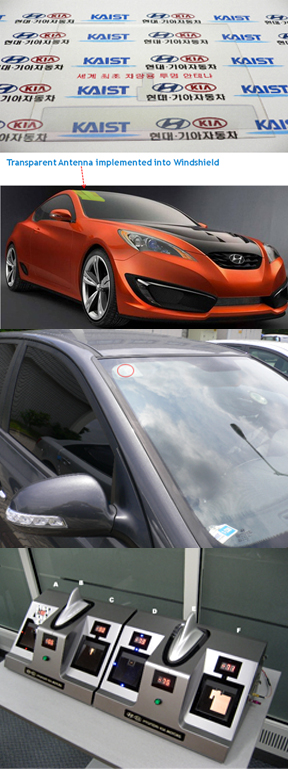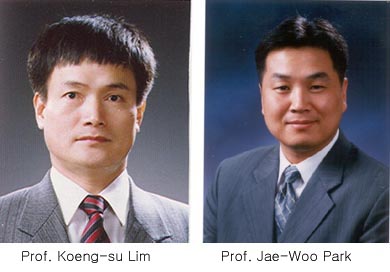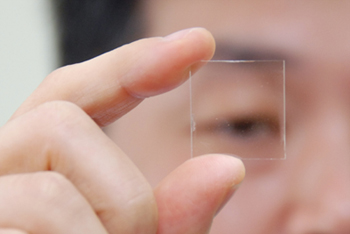Jae-Woo+Park
-
 Transparent Antenna for Automobile Developed
A research team led by Prof. Jae-Woo Park of the School of Electrical Engineering & Computer Science, KAIST, developed a transparent antenna for the next-generation automobiles, university authorities said on Monday (Aug. 17).
The development was made possible through joint researches with the Hyundai-Kia Automotive Group; Winncom, a car antenna manufacturer; and a group of researchers led by Han-Ki Kim of the Department of Display Materials Engineering at Kyung Hee University in Seoul.
The transparent antennas were developed in two kinds -- one for the HSDPA (High-Speed Downlink Packet Access), a new protocol for mobile telephone data transmission, and the other for transmitting and receiving radio wave for emergency call.
Using the transparent electrically conductive film formation technology, the transparent antennas are to be mounted on the windshield of a vehicle.
"The development of transparent antenna represents a step forward for the advancement of the next-generation automotive electronic technology," said Seong-woo Kim, a senior researcher at the Hyundai-Kia Group.
2009.08.18 View 14877
Transparent Antenna for Automobile Developed
A research team led by Prof. Jae-Woo Park of the School of Electrical Engineering & Computer Science, KAIST, developed a transparent antenna for the next-generation automobiles, university authorities said on Monday (Aug. 17).
The development was made possible through joint researches with the Hyundai-Kia Automotive Group; Winncom, a car antenna manufacturer; and a group of researchers led by Han-Ki Kim of the Department of Display Materials Engineering at Kyung Hee University in Seoul.
The transparent antennas were developed in two kinds -- one for the HSDPA (High-Speed Downlink Packet Access), a new protocol for mobile telephone data transmission, and the other for transmitting and receiving radio wave for emergency call.
Using the transparent electrically conductive film formation technology, the transparent antennas are to be mounted on the windshield of a vehicle.
"The development of transparent antenna represents a step forward for the advancement of the next-generation automotive electronic technology," said Seong-woo Kim, a senior researcher at the Hyundai-Kia Group.
2009.08.18 View 14877 -
 KAIST Scientists Creates Transparent Memory Chip
--See-Through Semis Could Revolutionize Displays
A group of KAIST scientists led by Prof. Jae-Woo Park and Koeng-Su Lim has created a working computer chip that is almost completely clear -- the first of its kind.
The new chip, called "transparent resistive random access memory (TRRAM), is similar in type to an existing technology known as complementary metal-oxide semiconductor (CMOS) memory -- common commercial chips that provide the data storage for USB flash drives and other devices. Like CMOS devices, the new chip provides "non-volatile" memory, meaning that it stores digital information without losing data when it is powered off. Unlike CMOS devices, however, the new TRRAM chip is almost completely clear.
The paper on the new technology, entitled "Transparent resistive random access memory and its characteristics for non-volatile resistive switching," was published in the December issue of the Applied Physics Letters (APL), and the American Institute of Physics, the publisher of APL, issued a press release about this breakthrough.
"It is a new milestone of transparent electronic systems," says researcher Jung-Won Seo, who is the first author of the paper. "By integrating TRRAM devices with other transparent electronic components, we can create a totally see-through embedded electronic system."
Technically, TRRAM devices rely upon an existing technology known as resistive random access memory (RRAM), which is already in commercial development for future electronic data storage devices. RRAM is built using metal oxide materials between equally transparent electrodes and substrates.
According to the research team, TRRAM devices are easy to fabricate and may be commercially available in just 3-4 years.
"We are sure that TRRAM will become one of alternative devices to current CMOS-based flash memory in the near future after its reliability is proven and once any manufacturing issues are solved," says Prof. Jae-Woo Park, who is the co-author on the paper. He adds that the new devices have the potential to be manufactured cheaply because any transparent materials can be utilized as substrate and electrode. They also may not require incorporating rare elements such as Indium.
2008.12.17 View 18169
KAIST Scientists Creates Transparent Memory Chip
--See-Through Semis Could Revolutionize Displays
A group of KAIST scientists led by Prof. Jae-Woo Park and Koeng-Su Lim has created a working computer chip that is almost completely clear -- the first of its kind.
The new chip, called "transparent resistive random access memory (TRRAM), is similar in type to an existing technology known as complementary metal-oxide semiconductor (CMOS) memory -- common commercial chips that provide the data storage for USB flash drives and other devices. Like CMOS devices, the new chip provides "non-volatile" memory, meaning that it stores digital information without losing data when it is powered off. Unlike CMOS devices, however, the new TRRAM chip is almost completely clear.
The paper on the new technology, entitled "Transparent resistive random access memory and its characteristics for non-volatile resistive switching," was published in the December issue of the Applied Physics Letters (APL), and the American Institute of Physics, the publisher of APL, issued a press release about this breakthrough.
"It is a new milestone of transparent electronic systems," says researcher Jung-Won Seo, who is the first author of the paper. "By integrating TRRAM devices with other transparent electronic components, we can create a totally see-through embedded electronic system."
Technically, TRRAM devices rely upon an existing technology known as resistive random access memory (RRAM), which is already in commercial development for future electronic data storage devices. RRAM is built using metal oxide materials between equally transparent electrodes and substrates.
According to the research team, TRRAM devices are easy to fabricate and may be commercially available in just 3-4 years.
"We are sure that TRRAM will become one of alternative devices to current CMOS-based flash memory in the near future after its reliability is proven and once any manufacturing issues are solved," says Prof. Jae-Woo Park, who is the co-author on the paper. He adds that the new devices have the potential to be manufactured cheaply because any transparent materials can be utilized as substrate and electrode. They also may not require incorporating rare elements such as Indium.
2008.12.17 View 18169 -
 Home-Grown Transparent Thin Film Transistor Developed
KAIST, Aug. 6, 2008 -- A KAIST research team led by Profs. Jae-Woo Park and Seung-Hyup Yoo of the Electrical Engineering Division has developed a home-grown technology to create transparent thin film transistor using titanium dioxide., university authorities said.The KAIST team made the technological advance in collaboration with the LCD Division of Samsung Electronics and the Techno Semichem Co., a local LCD equipment maker. Transparent thin film transistor continues to enjoy a wealth of popularity and intensive research interest since it is used in producing operating circuits including transparent display, active-matrix OLED (AMOLED) display and flexible display.
The new technology is significant in that it is based on a titanium dioxide, the first such attempt in the world, while the technologies patented by the United States and Japan are based on ZnO.
Researchers will continue to work on securing technological reliability and developing a technology to mass-produce in a large-scale chemical vapor deposition equipment for the next couple of years.
"The development of technology to produce transparent thin film transistor will help Korean LCD makers reduce its dependence on foreign technologies, as well as maintain Korea"s status as a leader of the world"s display industry," said Prof. Park.
KAIST has applied for local patent registration of the technology and the process is expected to complete by this October or November. International patents have been also applied for in the U.S., Japan and Europe.
The new technology was introduced in the latest edition of the Electron Device Letters, a journal published by the Institute of Electrical and Electronics Engineers or IEEE, a New York-based international non-profit, professional organization for the advancement of technology related to electricity. It will be presented at the International Display Workshop 2008 on Dec. 5 in Niigata, Japan.
2008.08.07 View 16647
Home-Grown Transparent Thin Film Transistor Developed
KAIST, Aug. 6, 2008 -- A KAIST research team led by Profs. Jae-Woo Park and Seung-Hyup Yoo of the Electrical Engineering Division has developed a home-grown technology to create transparent thin film transistor using titanium dioxide., university authorities said.The KAIST team made the technological advance in collaboration with the LCD Division of Samsung Electronics and the Techno Semichem Co., a local LCD equipment maker. Transparent thin film transistor continues to enjoy a wealth of popularity and intensive research interest since it is used in producing operating circuits including transparent display, active-matrix OLED (AMOLED) display and flexible display.
The new technology is significant in that it is based on a titanium dioxide, the first such attempt in the world, while the technologies patented by the United States and Japan are based on ZnO.
Researchers will continue to work on securing technological reliability and developing a technology to mass-produce in a large-scale chemical vapor deposition equipment for the next couple of years.
"The development of technology to produce transparent thin film transistor will help Korean LCD makers reduce its dependence on foreign technologies, as well as maintain Korea"s status as a leader of the world"s display industry," said Prof. Park.
KAIST has applied for local patent registration of the technology and the process is expected to complete by this October or November. International patents have been also applied for in the U.S., Japan and Europe.
The new technology was introduced in the latest edition of the Electron Device Letters, a journal published by the Institute of Electrical and Electronics Engineers or IEEE, a New York-based international non-profit, professional organization for the advancement of technology related to electricity. It will be presented at the International Display Workshop 2008 on Dec. 5 in Niigata, Japan.
2008.08.07 View 16647